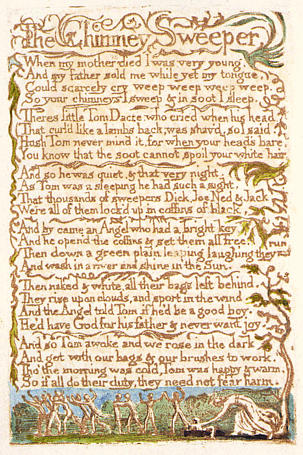


William Blake (1757-1827)
Songs of Innocence and Experience
-
"Songs is notable not only for a concern with the different ways
children and adults see and understand the world (a theme that would occupy
Wordsworth, too) but also for its acid critiques of social evils, political
injustice, and their agents" (150).
Homework Questions:
150:
-
What is significant about Blake's use of illuminated texts?
157:
-
Explain: "Blake's point is not that children are pure and adults
fallen, or that children are naive and adults perspicacious. The
contrary possibilities coexist, with different plays and shades of emphasis
in different poems" (157).
"The Chimney Sweeper"
161:
-
What is significant about the comparison of Tom's hair with a lamb's
wool (6)?
-
What is the significance of the black and white imagery used in the
poem?
174:
-
How does the message of this poem compare with that found in the Songs
of Innocence version?
-
Explain lines 9-10
"The Tyger:
177:
-
What does Blake mean by "the forests of the night" (2)?
-
Explain the imagery used in lines 13-16.
-
What is the speaker's answer to the question in line 20?
"London"
179:
-
What are mind-forg'd manacles (8)? How does this image compare with
the imagery found in lines 13-16 of "The Tyger"?
Other Discussion Questions:
156:
-
Explain: "Childhood is a time and a state of protected 'innocence,'
but it is a qualified innocence, not immune to the fallen world and its
institutions" (156).
157:
-
Explain: "Unlike Milton's narrative of the Fall from Paradise,
Blake shows either state of soul possible at any moment" (157).
-
Explain: "Blake, like Mary Wollstonecraft, implicates innocence
with dangerous ignorance and vulnerability to oppression" (157).
"The Chimney Sweeper"
162:
-
What does Blake mean by duty in the final line (24)?
174:
-
What are "the clothes of death" (7)?
-
Explain line 12.
"London"
179:
-
What does charter'd mean (1)?
-
What is the "marriage hearse" (16)?


